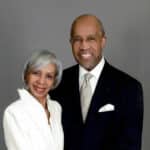The financial objectives and risks for retirees, including those nearing retirement, can be different than those of wealth builders. Constructing and managing investment portfolios for retirees should also be different!
When you build an investment portfolio for a client who is nearing or is in retirement, address their near- and long-term needs by including two distinct investment categories. The first, non-discretionary investments, includes securities over which you have virtually no discretion and are earmarked for near-term, anticipated financial needs. The second, discretionary investments, includes securities that are chosen applying your judgment of what assets to employ to meet long-term financial needs. Both categories are dependent upon your client’s expected and future cash needs.
As you begin to develop of your client’s financial plan, consider their spending patterns and near-term financial requirements, quantify an appropriate asset mix adjusted for when they retire, and protect their long-term purchasing power. This article discusses those tasks and presents a three-step process to build dynamic investment portfolios to address the short- and long-term financial needs unique to each of your clients.
Step 1: Spending Patterns
The non-discretionary investments, which will be determined by the spending patterns of your client, should be taken care of first when building their investment portfolios. Begin by asking your client to compile a list of their current expenses, anticipated sources of regular income in retirement, and large one-time expenses or income they expect for as many years in the future as practical.
With that information in hand, you can prepare inflation-adjusted estimates of how much money your client may need to take annually from their investments for several years in retirement. Use those results to select individual fixed-income securities whose maturities match your client’s expected annual cash flow needs in much the same way that insurance companies apply asset-liability matching techniques. For example, if the analysis suggests your client will need to withdraw $50,000 from their financial assets in each of their first five years of retirement, invest $50,000 par value or more in individual bonds that mature in each of those years.
To manage the risk of a bond issuer defaulting on those bonds, limit purchases to bonds assigned the highest credit ratings of AAA, AA or A by Standard and Poor’s. Consider selling any bond that falls below those ratings.
Be sure you complete this initial step of taking care of the near-term financial needs of your client before you move on to their long-term needs. After all, having a wonderful long-term plan may be impressive but you can’t get to long term if you don’t take care of the short term first!
Step 2: Asset Mix
After you’ve planned for the near-term, non-discretionary investments, the next step is to prepare for the discretionary holdings. Investments in the discretionary portion of the portfolio require you to quantify a long-term target mix of assets that reflects your client’s unique investment profile. At SmithAsset Management, we complete our client’s investment profile by employing a proprietary process to identify the level of returns a client would like to receive on their investments, along with their sensitivity to volatility in the market value of their assets. That information, along with specific market data, is then used to quantify their long term target mix of assets.
In my view, the asset mix for retirees should be dynamic and not simply a downward glide path for equities. Their current mix of assets and when it evolves to match their long-term target mix is generally determined by when your client plans to retire. Specifically, research conducted by Wade Pfau and others suggested that the portion of assets invested in volatile equity securities could be reduced for several years before and after retirement. The objective of making downward and upward adjustments to equities is to increase the probability that a retirement plan will succeed by reducing its sequence of return risk.
For example, let’s say your client has a $1,000,000 portfolio and they will require a total of $250,000 for their near-term non-discretionary needs over the next five years. In addition, your analysis suggests an appropriate long-term target asset mix for the remaining $750,000 of discretionary investments would include 60% stocks and 40% bonds. In the five years before retirement, consider reducing the equity portion of their $750,000 discretionary holdings each year so they have only 20% invested in stocks before they retire. I suggest using a target of 20% for stocks, within a range of 15 % to 25%, modified to reflect your client’s unique ability and willingness to accept stock market price volatility. Later, when your client has settled into a comfortable retirement and their financial situation is stable, increase their exposure to equities annually until the $750,000 discretionary portion of their portfolio reaches its long-term target asset mix of 60% equities and 40% bonds.
Step 3: Long-Term Portfolio
Up to this point, you’ve developed an investment profile of your client, taken care of their non-discretionary financial needs, and quantified the long-term target asset mix for the remainder of their portfolio. Now it’s time to select specific discretionary investments using no-load equity funds and individual fixed-income securities. You may want to steer clear of the myriad of other financial products and derivatives unless you are an expert in those areas.
Equities, specifically no-load mutual funds and exchange-traded funds (EFTs), may be attractive because of their potential to generate relatively attractive returns that protect the purchasing power of your client’s assets. Funds may also lower risk because they hold many stocks, which reduces non-systematic risks. That is in contrast to individual stocks, which face many risks specific to the issuing organization as well as potential revaluation of the stock’s price-to-earnings multiple.
First, select equity funds that are considered attractive relative to their peer group. Be sure to diversify the holdings among several market-capitalization sectors and by the growth or value security-selection methodology used by their portfolio managers. In addition, incorporate several fund families as well as domestic and international funds.
I suggest you do not place excessive emphasis on the management fees, or management expense ratio, charged by various mutual funds and ETFs. Instead, compare what you get versus what it costs. For example, let’s suppose actively-managed Fund A is expected to return 10% annually and has management fees of 1% while Fund B is expected to return 20% annually and has management fees of 2%. Given that everything else is equal, which they rarely are, I’d select Fund B because of its superior expected return net of its higher management fees.
When it comes to fixed-income securities, focus on individual U.S. Treasurys, corporate and municipal bonds, and certificates of deposit for the discretionary portion of the portfolio. Individual bonds may virtually eliminate market risk (interest rate risk) if they are held to maturity regardless of interim price fluctuations. On the other hand, bond funds generally have no set maturity dates so their prices can fall indefinitely if interest rates rise.
Individual bonds also offer you the benefits of managing their anticipated maturities and quality ratings. Specifically, concentrating on bonds with short- to intermediate-term maturities may reduce their price volatility while laddering maturities can temper the impact of interest rate cycles. Apply the same credit-rating criteria outlined in Step 1 when deciding which individual bonds you choose for this portion of the portfolio.
Summary
When all of the pieces are assembled, your client’s investment portfolio will likely have two components. The non-discretionary portion may be relatively stable and includes individual bonds whose maturities are structured to match anticipated cash withdrawals. The discretionary component will likely exhibit greater volatility and may include no-load equity funds and individual bonds that are intended to preserve the long-term purchasing power of your client.
Additional Reading: The Only Way to Help Clients Enjoy Retirement
I’ve found that segregating the two components into separate accounts, if possible, will increase a client’s comfort with the portfolio because the purpose of each investment will be easier to identify. Specifically, place the non-discretionary portion in one account and the discretionary portion in a different account. That way a client will know their financial needs are relatively secure for several years in their non-discretionary account regardless of how volatile the discretionary account might be. Move money between the accounts in the future as their cash flow needs evolve. You might also seek input from your client’s tax professional to determine a tax efficient strategy for separating assets into pre-tax and after-tax accounts.
Epilogue: Beyond the Numbers
In addition to financial planning, encourage your client to think about what they will do after they leave work. Ask them to consider how they might feel to part with their steady source of income or to say goodbye to friends they had at the workplace. How do they envision spending their days? Are there things they still want to accomplish? An open discussion of these and other potential challenges may help your client transition to a successful retirement and could also strengthen your relationship with them.
Frank Smith, CFA, RICP, MBA, is fiercely proud of the personal and award winning investment advisory services he provides to clients who are retired, near retirement or are building their wealth. Frank draws on 40 years of experience and continuous training as an analyst and portfolio manager. Frank has been named “Best Investment Advisory Service Provider-Northeast USA,” “Five Star Wealth Manager” and “Best Investment Firm in Bucks County.” He can be reached at (215) 321-6663, SmithAsset@aol.com, or FrankSmithInvestments.com.







